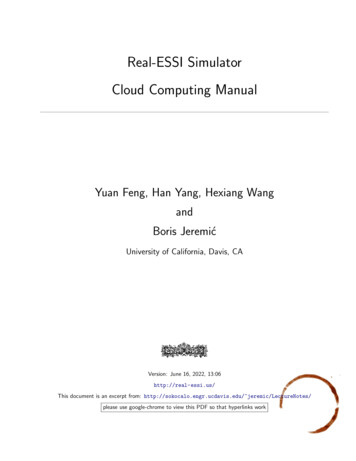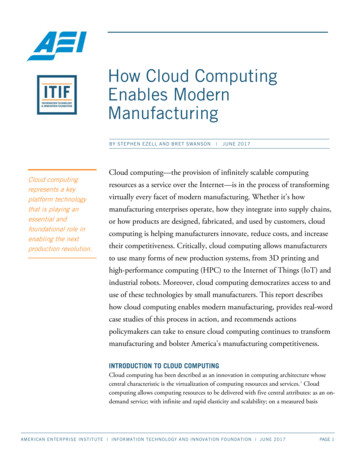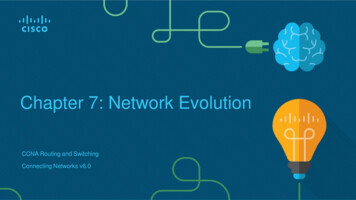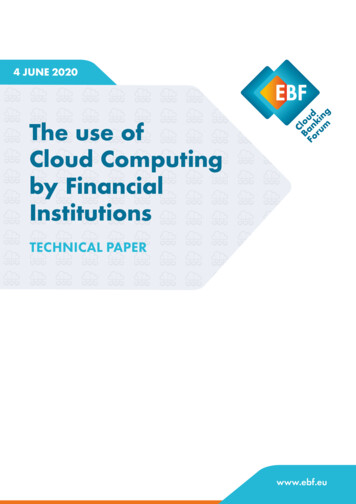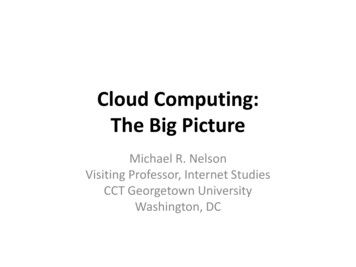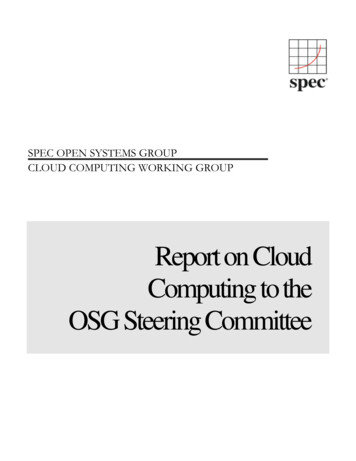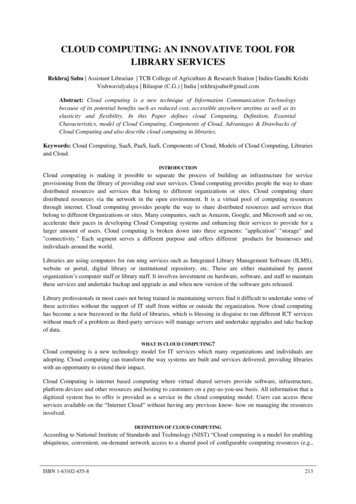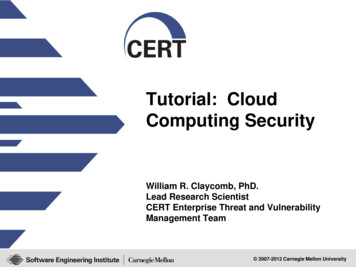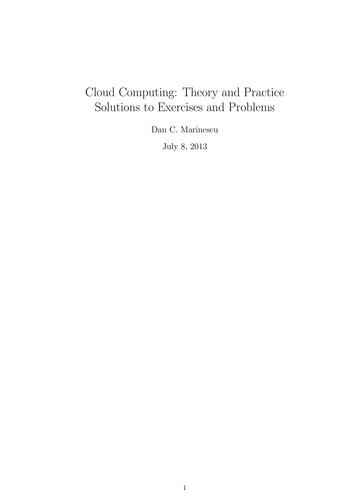
Transcription
Cloud Computing: Theory and PracticeSolutions to Exercises and ProblemsDan C. MarinescuJuly 8, 20131
Contents1 Chapter 1 - Preliminaries32 Chapter 2 - Basic Concepts93 Chapter 3 - Infrastructure204 Chapter 4 - Applications295 Chapter 5 - Virtualization386 Chapter 6 - Resource Management497 Chapter 7 - Networking568 Chapter 8 - Storage659 Chapter 9 - Security7310 Chapter 10 - Complex Systems8411 Literature912
1Chapter 1 - PreliminariesProblem 1. Mobile devices could benefit from cloud computing; explain the reasons you thinkthat this statement is true or provide arguments supporting the contrary. Discuss several cloudapplications for mobile devices; explain which one of the three cloud computing delivery models,SaaS, PaaS, or IaaS, would be used by each one of the applications and why.Mobile devices, such as smart phones and tablets, have limited power reserves thus, cannot carry out intensive computations or store excessive amounts of data; such devices cantake advantage of high-speed WiFi connection to access data stored on a cloud and steercomputations running on a cloud. Data sharing is a another major reason for mobile cloudapplications; images, videos, music, or any other type of data stored on a cloud can be accessedby any device connected to the Internet and shared with others.Videos and music can be streamed from a cloud supporting the SaaS delivery model.Massive Multi-player Online Games (MMOG) which require significant computing resourcescould be hosted by a cloud and accessed from tablets, smart phones or any other type of mobiledevices. Scientific data processed and stored on a cloud can be shared by a community ofresearchers. Massive amounts of data can be processed on platforms supporting PaaS or IaaScloud delivery models.The latest WiFi technology, 802.11ac, with speeds of up to 1.3 Gbps, will most certainlylead to an increase of mobile applications of cloud computing. As the functionality and thediversity of sensors embedded in mobile devices increasers, we expect new mobile applications in areas as diverse as healthcare, education, entertainment, security, commerce, trafficmonitoring, social networks, and so on.Problem 2. Do you believe that the homogeneity of a large-scale distributed systems is anadvantage? Discuss the reasons for your answer. What aspects of hardware homogeneity arethe most relevant in your view and why? What aspects of software homogeneity do you believeare the most relevant and why?Yes, homogeneity offers distinct advantages to the providers of computing resources andto the users of the systems.It is expensive and technically challenging to maintain a large number of systems withdifferent architecture, system software, and account management policies. Software and hardware updates are labor intensive. It is far from trivial to offer the user community a friendlyenvironment and support fault-tolerance and other highly desirable system attributes. Insuch a heterogeneous environment data migration may require conversion and process migration could be extremely challenging. The users have to make sure that their applications usesimilar compilers and application libraries when running on different systems.Hardware homogeneity reduces maintenance costs and may also reduce the initial investment cost as large numbers of systems are acquired from the same vendor. When all systemsare running identical or similar system software, software maintenance can be automated andupdates can be applied at the same time; this reduces the security exposure of the systems.The users benefit as the system offers a unique image. Data and process migration can beeasily implemented both at the system and user level.Problem 3. Peer-to-peer systems and clouds share a few goals, but not the means to accomplish them. Compare the two classes of systems in terms of architecture, resource management,scope, and security.3
Peer-to-peer systems allow individuals to share data and computing resources, primarilystorage space without sharing the cost of these resources; sharing other types of resources,such as computing cycles, is considerably more difficult. P2P systems have several desirableproperties [67]: Require a minimally dedicated infrastructure, since resources are contributed by theparticipating systems. Are highly decentralized. Are scalable; the individual nodes are not required to be aware of the global state. Are resilient to faults and attacks, since few of their elements are critical for the deliveryof service and the abundance of resources can support a high degree of replication. Individual nodes do not require excessive network bandwidth the way servers used incase of the client-server model do. The systems are shielded from censorship due to the dynamic and often unstructuredsystem architecture.Decentralization raises the question of whether P2P systems can be managed effectivelyand provide the security required by various applications. The fact that they are shieldedfrom censorship makes them a fertile ground for illegal activities, including distribution ofcopyrighted content.A peer-to-peer system is based on an ad-hoc infrastructure where individuals contributeresources to the system, but join and leave the system as they wish; thus, a high degree ofredundancy is necessary, the information must be replicated on multiple sites. A peer-to-peersystem maintains a directory of data and sites; this directory can be at a central site ordistributed.The need to make computing and storage more affordable and to liberate users from theconcerns regarding system and software maintenance reinforced the idea of concentratingcomputing resources in large cloud computing centers; the users pay only for the resourcesthey use thus, the name utility computing. In both cases the resources are accessed thoughthe Internet and the applications are based on a client-server model with a thin client. Thedefining attributes of the cloud computing paradigm are: Cloud computing uses Internet technologies to offer elastic services. The term elasticcomputing refers to the ability to dynamically acquire computing resources and supporta variable workload. A cloud service provider maintains a massive infrastructure tosupport elastic services. The resources used for these services can be metered and the users can be charged onlyfor the resources they use. Maintenance and security are ensured by service providers. Economy of scale allows service providers to operate more efficiently due to specializationand centralization.4
Cloud computing is cost-effective due to resource multiplexing; lower costs for the serviceprovider are passed on to the cloud users. The application data is stored closer to the site where it is used in a device- and locationindependent manner; potentially, this data storage strategy increases reliability andsecurity and, at the same time, it lowers communication costs.A cloud computing center is managed by a cloud service provider which owns the serversand the networking infrastructure. Services are provided based on SLAs (Service Level Agreement). A cloud provides reliable storage and the data is automatically replicated. The levelof user control of the cloud resources is different for the three cloud delivery models.Security is a major concern in both cases, especially in the case of cloud computing.Problem 4. Compare the three cloud computing delivery models, SaaS, PaaS, and IaaS,from the point of view of the application developers and users. Discuss the security and thereliability of each one of them. Analyze the differences between the PaaS and the IaaS.Software-as-a-Service (SaaS) gives the capability to use applications supplied by the service provider in a cloud infrastructure. The applications are accessible from various client devices through a thin-client interface such as a Web browser (e.g., Web-based email). The userdoes not manage or control the underlying cloud infrastructure, including network, servers,operating systems, storage, or even individual application capabilities, with the possible exception of limited user-specific application configuration settings.SaaS is not suitable for applications that require real-time response or those for which datais not allowed to be hosted externally. The most likely candidates for SaaS are applicationsfor which: Many competitors use the same product, such as email. Periodically there is a significant peak in demand, such as billing and payroll. There is a need for Web or mobile access, such as mobile sales management software. There is only a short-term need, such as collaborative software for a project.Platform-as-a-Service (PaaS) gives the capability to deploy consumer-created or acquiredapplications using programming languages and tools supported by the provider. The user doesnot manage or control the underlying cloud infrastructure, including network, servers, operating systems, or storage. The user has control over the deployed applications and, possibly,over the application hosting environment configurations. Such services include session management, device integration, sandboxes, instrumentation and testing, contents management,knowledge management, and Universal Description, Discovery, and Integration (UDDI), aplatform-independent Extensible Markup Language (XML)-based registry providing a mechanism to register and locate Web service applications.PaaS is not particulary useful when the application must be portable, when proprietaryprogramming languages are used, or when the underlaying hardware and software must becustomized to improve the performance of the application. The major PaaS applicationareas are in software development where multiple developers and users collaborate and thedeployment and testing services should be automated.5
Infrastructure-as-a-Service (IaaS) offers the capability to provision processing, storage,networks, and other fundamental computing resources; the consumer is able to deploy andrun arbitrary software, which can include operating systems and applications. The consumerdoes not manage or control the underlying cloud infrastructure but has control over operatingsystems, storage, deployed applications, and possibly limited control of some networkingcomponents, such as host firewalls. Services offered by this delivery model include: serverhosting, Web servers, storage, computing hardware, operating systems, virtual instances, loadbalancing, Internet access, and bandwidth provisioning.The IaaS cloud computing delivery model has a number of characteristics, such as thefact that the resources are distributed and support dynamic scaling, it is based on a utilitypricing model and variable cost, and the hardware is shared among multiple users. This cloudcomputing model is particulary useful when the demand is volatile and a new business needscomputing resources and does not want to invest in a computing infrastructure or when anorganization is expanding rapidly.Problem 5. Overprovisioning is the reliance on extra capacity to satisfy the needs of alarge community of users when the average-to-peak resource demand ratio is very high. Givean example of a large-scale system using overprovisioning and discuss if overprovisioningis sustainable in that case and what are the limitations of it. Is cloud elasticity based onoverprovisioning sustainable? Give the arguments to support your answer.The Internet is probably the best known example of a large-scale system based on overprovisioning. Indeed, the backbones of different ISPs (Internet Service Providers) are highcapacity fiber optic channels able to support a very high volume of network traffic, ordersof magnitude larger than the average traffic. This is economically feasible because the costof a high-capacity fiber channel is only a fraction of the total cost for installing the fiber.Nevertheless, the Internet bandwidth available to individual customers is limited by the socalled “last mile” connection, the last link connecting a home to a node of ISP’s network.Another important aspect is that the Internet is based on a “Best Effort” paradigm thus, therouters of a heavily loaded network are allowed to drop packets.Overprovisioning in a computer cloud is a consequence of the commitment to support an“elastic” computing environment, in other words, to supply additional resource to the userswhen they are needed. Thus, the CSPs (Cloud Service Providers) maintain an infrastructureconsiderably larger than the one capable to respond to the average user needs, and the averageserver utilization is low, say in the range to 20-40 %. The cost for supporting such aninfrastructure cannot be economically justified. This cost has two basic components, theinitial investment and the recurring costs for energy consumption, maintenance, and so on.Arguably, the cost for the initial investment cannot be reduced if the CSP is really committedto cloud elasticity, but can be controlled if the SLAs require a user to specify both the averageand the maximum level of resource consumption. Then the cloud resource management shouldimplement an admission control policy to ensure that the system can satisfy all its existingcommitments and does not have to pay penalties for breaking the contractual agreements.The recurring costs can be reduced by migrating applications from lightly loaded systems andby turning them to a sleep mode to reduce power consumption.Problem 6. Discuss the possible solution for stabilizing cloud services mentioned in [26]inspired by BGP (Border Gateway Protocol) routing [37, 84].6
In the paper “Icebergs in the Clouds: the Other Risks of Cloud Computing” B. Fordexpresses a concern related to instability risks from interacting services: “Cloud services andapplications increasingly build atop one another in ever more complex ways, such as cloudbased advertising or mapping services used as components in other, higher-level cloud-basedapplications, all of these building on computation and storage infrastructure offered by stillother providers. Each of these interacting, code-pendent services and infrastructure components is often implemented, deployed, and maintained independently by a single companythat, for reasons of competition, shares as few details as possible about the internal operationof its services.”The author suggests: “ One place we might begin to study stability issues between interacting cloud services, and potential solutions, is the extensive body of work on the unexpectedinter-AS (Autonomous System) interactions frequently observed in BGP routing[37, 84]. Inparticular, the “dependency wheel” model, useful for reasoning about BGP policy loops,seems likely to generalize to higher-level control loops in the cloud, such as load balancingpolicies. Most of the potential solutions explored so far in the BGP space, however, appearlargely specific to BGPor at least to routingand may have to be rethought “from scratch” inthe context of more general, higher-level cloud services. Beyond BGP, classic control theorymay offer a broader source of inspiration for methods of understanding and ensuring cloudstability. Most conventional control-theoretic techniques, however, are unfortunately constructed from the assumption that some “master system architect” can control or at leastdescribe all the potentially-interacting control loops in a system to be engineered. The cloudcomputing model violates this assumption at the outset by juxtaposing many interdependent,reactive control mechanisms that are by nature independently developed, and are often theproprietary and closely-guarded business secrets of each provider.”The ever increasing depth of the software stack is likely to lead to new security andperformance concerns. At the same time, a realistic standardization effort runs contrary tothe interests of cloud service providers.Problem 7. An organization debating whether to install a private cloud or to use a publiccloud, e.g., the AWS, for its computational and storage needs, asks your advice. What information will you require to base your recommendation on, and how will you use each one ofthe following items: (a) the description of the algorithms and the type of the applications theorganization will run; (b) the system software used by these applications; (c) the resourcesneeded by each application; (d) the size of the user population; (e) the relative experience ofthe user population; (d) the costs involved.Public clouds have distinct cost advantages over private clouds; there is no initial investment in the infrastructure, no recurring costs for administration, maintenance, energyconsumption, and for the user support personnel. The main concern is security and privacy.An organization with very strict security and privacy concerns is very unlikely to use a publiccloud.The type of applications play a critical role, scientific and engineering computations whichrequire a low latency interconnection network and enjoy only fine-grain parallelism are unlikelyto fare well on either a public or a private cloud. A large user population is more likely to useidentical or similar software and to cooperate by sharing the raw data and the results; thus,a private cloud seems more advantageous in this case. Some of the services offered by privateclouds target experiences users, e.g., AWS services such as ElasticBeanstalk, while others areaccessible to lay persons.7
Problem 8. A university is debating the question in Problem 7. What will be your adviceand why? Should software licensing be an important element of the decision?Both education and research are university activities that could benefit from cloud computing. A public cloud is probably an ideal environment for education; indeed, security is nota significant concern for computing related to education. The student computational activitypeaks when projects and other assignments are due and it is relatively low during the remaining of a semester thus, the investment into a large infrastructure needed for brief periods oftime do not seem to be justified. Moreover, once a student learns how to use a cloud service,e.g., AWS, this skill could help in finding a job and then during his/her employment. Thestudents share the software for their assignments and a public cloud could provide an idealenvironment for group projects. Software licensing can be a problem as some projects mayrequire the use of licensed software.The benefits of a private cloud for supporting university research is increasingly morequestionable as the cost of the hardware decreases and the computational needs of manyresearch groups can be met with a medium or a high-end server which costs only a fewthousand dollars. Of course, some research groups may need access to supercomputers butacquiring a supercomputer is only justified for a very few well-funded research universities.Problem 9. An IT company decides to provide free access to a public cloud dedicated tohigher education. Which one of the three cloud computing delivery models, SaaS, PaaS, orIaaS should it embrace and why? What applications would be most beneficial for the students?Will this solution have an impact on distance learning? Why?A public cloud dedicated to higher education would be extremely beneficial; it wouldallow concentration of educational resources and sharing of software for different educationalactivities. It would increase the student participation and interest in the different topics. Atthe same time, it would significantly reduce the cost of educational computing.Each one of the three cloud delivery models would have its own applications. For example,SaaS could be uses for testing and for systems like Piazza (see https://piazza.com/) whichallow groups of students and faculty to interact. Collaborative environments which allowan instructor to interact with a large class where the students are connected via mobiledevices would most certainly increase the level of student participation. Projects given toengineering and science students would have useful results as the students would be able torun concurrently multiple models of the systems and use different parameters of the models.Such projects would require either a Paas or an IaaS cloud model.8
2Chapter 2 - Basic ConceptsProblem 1. Non-linear algorithms do not obey the rules of scaled speed-up. For example,it was shown that when the concurrency of an O(N 3 ) algorithm doubles, the problem sizeincreases only by slightly more than 25%. Read [75] and explain this result.The author of [75] writes:“As a practical matter the scientific and commercial problemsthat are most in need of speedup are the so-called compute-bound problems since the I/Obound problems would yield to better data transmission technology not more processingcapability. These compute-bound problems are generally super-linear, typically exhibitingsequential time complexity in the range O(n2 ) to O(n4 ) for problems of size n. The reasonO(n4 ) problems are common in science and engineering is that they often model physicalsystems with three spatial dimensions developing in time. A frequent challenge with theseproblems is not to solve a fixed-size instance of the problem faster, but rather to solve largerinstances within a fixed time budget. The rationale is simple: The solutions are so computationally intensive that problem instances of an interesting size do not complete execution ina tolerable amount of time. Here “tolerable” means the maximum time the machine can bemonopolized or the scientist can wait between experiments. Thus, with present performancethe scientist solves a smaller-than-desirable problem to assure tolerable turnaround. The factthat the tolerable turnaround time will remain constant implies that increased performancewill be used to attack larger problems.What is the effect of parallelism on problem size? Keeping time fixed at t and (unrealistically) assuming the best possible speedup, it follows that super-linear problems can beimproved only sub-linearly by parallel computation. Specifically, if a problem takest cnx(1)sequential steps, and if the application of p processors permits an increase in the problem sizeby a factor of mt c(mn)x /p(2)the problem size can increase by at most a factor ofm p1/x(3)For example, to increase by two orders of magnitude the size of a problem whose sequentialperformance is given byt cn4(4)requires, optimistically, 100, 000, 000 processors.”Problem 2. Given a system of four concurrent threads t1 , t2 , t3 and t4 we take a snapshot ofthe consistent state of the system after 3, 2, 4, and 3 events in each thread, respectively; all butthe second event in each thread are local events. The only communication event in thread t1 isto send a message to t4 and the only communication event in thread t3 is to send a message tot2 . Draw a space-time diagram showing the consistent cut; mark individual events on threadti as eji .9
How many messages are exchanged to obtain the snapshot in this case? The snapshot protocol allows the application developers to create a checkpoint. An examination of the checkpoint data shows that an error has occurred and it is decided to trace the execution. Howmany potential execution paths must be examined to debug the system?Figure 1 shows the space-time diagram and the consistent cut C1 (e31 , e22 , e43 , e34 ).12ee113e145116ee e1t1Cmm15112e3e2e22t21e3t3e41t42e3me4522e e6e223345ee33e42 e43e44Figure 1: Space-time diagram for four concurrent threads t1 , t2 , t3 and t4 when all, but thesecond event in each thread, are local. The only communication event in thread t1 is to senda message to t4 and the only communication event in thread t3 is to send a message to t2 . Thecut C1 (e31 , e22 , e43 , e34 ) is consistent, it does not include non-causal events, e.g., the receivingof a message without the event related to the sending of the message.The snapshot protocol of Chandy and Lamport consists of three steps [16]1. Process p0 sends to itself a “take snapshot” message.2. Let pf be the process from which pi receives the“take snapshot” message for the firsttime. Upon receiving the message, the process pi records its local state, σi , and relaysthe “take snapshot” along all its outgoing channels without executing any events onbehalf of its underlying computation; channel state ξf,i is set to empty and process pistarts recording messages received over each of its incoming channels.3. Let ps be the process from which pi receives the “take snapshot” message beyond thefirst time; process pi stops recording messages along the incoming channel from ps anddeclares channel state ξs,i as those messages that have been recorded.Each“take snapshot” message crosses each channel exactly once and every process pi hasmade its contribution to the global state; a process records its state the first time it receivesa “take snapshot” message and then stops executing the underlying computation for some10
time. Thus, in a fully connected network with n processes the protocol requires n (n 1)messages, one on each channel.In our case we have n 4 threads, t1 , t2 , t3 and t4 , thus the number of messages isMmsg n(n 1) 4 3 12.(5)The number of events to reach the state (3, 2, 4, 3) isn (3 2 4 3)!12! .(3! 2! 4! 3!)38(6)Problem 3. The run-time of a data-intensive application could be days, or possibly weeks,even on a powerful supercomputer. Checkpoints are taken for a long-running computationperiodically and when a crash occurs the computation is restarted from the latest checkpoint.This strategy is also useful for program and model debugging; when one observes wrong partialresults the computation can be restarted from a checkpoint where the partial results seem tobe right.Express η, the slowdown due to checkpointing, for a computation when checkpoints aretaken after a run lasting τ units of time and each checkpoint requires κ units of time. Discussoptimal choices for τ and κ.The checkpoint data can be stored locally, on the secondary storage of each processor, oron a dedicated storage server accessible via a high-speed network. Which solution is optimaland why?Assume that the computation requires n runs, each of duration τ units of time, thus therunning time without checkpointing isTnc n τ.(7)Then the running time with checkpointing isTc b (τ κ).(8)The slowdown is the ratio of the running time with checkpointing over the running timewithoutTcτ κκ 1 .(9)TncττThe slowdown is a function of the ratio κτ . The time required for checkpointing, κ, is afunction of the size of the snapshot thus, it is fixed for a given application. The only meansto affect the slowdown is the choice of τ .For a given κ, the smaller the ratio, the lower the slowdown, but the larger the timebetween two consecutive snapshots thus, the more significant the loss in case of a systemfailure. Assuming that a system failure in the interval τ is uniformly distributed, then theaverage time lost in case of a failure is τ /2. If τ κ then η 2, the execution time doubles;if τ 2κ then η 1.5 the execution time increases by 50% and so on.Checkpointing to a persistent storage device, e.g., disk, is I/O intensive, thus time consuming. In recent years, as the cost of the primary storage has decreased substantially, someadvocate checkpointing to primary storage, a much faster alternative. But the primary storageη 11
is volatile so the checkpoint is lost in case of a power failure. Also recovering the checkpointdata in case of a system failure could be challenging. An alternative is to checkpointing tothe primary storage and then transferring the checkpoint data to persistent storage while theapplication is running.The use of flash memories as the persistent storage will substantially reduce the time forwriting the snapshots to persistent storage.Problem 4. What is in your opinion the critical step in the development of a systematicapproach to all-or-nothing atomicity? What does a systematic approach means? What are theadvantages of a systematic versus an ad-hoc approach to atomicity?The support for atomicity affects the complexity of a system. Explain how the supportfor atomicity requires new functions/mechanisms and how these new functions increase thesystem complexity. At the same time, atomicity could simplify the description of a system;discuss how it accomplishes this.The support for atomicity is critical for system features which lead to increased performanceand functionality such as: virtual memory, processor virtualization, system calls, and userprovided exception handlers. Analyze how atomicity is used in each one of these cases.It is desirable to have a systematic approach rather than an ad-hoc one because atomicityis required in many contexts. It would be difficult to implement, difficult to use, and prone toerror to have ad-hoc implementations of atomicity for each context it is used for. A systematicapproach to atomicity must address several delicate questions:1. How to guarantee that only one atomic action has access to a shared resource at anygiven time.2. How to return to the original state of the system when an atomic action fails to complete.3. How to ensure that the order of several atomic actions leads to consistent results.There is not a single critical aspect in the development of a systematic approach to all-ornothing atomicity; of course all atomic actions should not expose the state of the system untilthe action is completed and should be able to redo all actions carried out before the commitpoint and, at the same time, provide answers to the delicate questions mentioned above.The first item requires some mechanism to serialize the access to shared data structures andother resources. This is commonly done by using locks, semaphores, or monitors. But each oneof these choices has its own problems and solving these problems adds to system complexity.For example, locks could lead to deadlocks and the system must include a lock manager thatattempt
ment). A cloud provides reliable storage and the data is automatically replicated. The level of user control of the cloud resources is different for the three cloud delivery models. Security is a major concern in both cases, especially in the case of cloud computing. Problem 4. Compare the three clou




